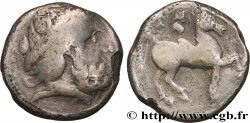v55_0601 - CELTI DEL DANUVIO Tétradrachme “au rameau”
MONNAIES 55 (2012)
起拍价 : 380.00 €
估价 : 600.00 €
竞价记录 : 380.00 €
起拍价 : 380.00 €
估价 : 600.00 €
竞价记录 : 380.00 €
种类 Tétradrachme “au rameau”
日期: (IIe-Ier siècles avant J.-C.)
材质 silver
直径 24,5 mm
模子方针 5 h.
重量 14,20 g.
稀少度 R2
关于品相的说明
Monnaie de bon style avec un beau portrait de haut relief, sur un flan un tout petit peu court et épais. Frappe centrée des deux côtés. Agréable patine grise, très légèrement tachée au revers
出版目录中的项代码 :
正面
正面的文字 ANÉPIGRAPHE.
正面的说明书 Tête laurée de Zeus à gauche, grènetis.
背面
背面的说明书 Cavalier au pas à gauche, tenant une palme de la main droite ; le cheval lève l'antérieur à droite ; légende dégénérée autour du cheval.
背面铭文 FILIP - POU
评论
Ce statère semble être des mêmes coins que le n° 688 de MONNAIES 28 et du n° 3 de la vente LANZ 154. Mis à part ces exemplaires, ce type précis semble manquer à tous les ouvrages et catalogues de musées consultés.
Si le statère d’or de Philippe II de Macédoine a servi de prototype à de nombreuses imitations gauloises, le tétradrachme n’a pas été imité en Gaule, mais reste principal sujet d’inspiration des monnaies pour les Celtes du Danube (LT. 9697-9767, 9768-9832, 9618-9630, 9870-9886). Les premières imitations furent frappées dans le premier quart du IIIe siècle avant J.-C. La fabrication des copies serviles, puis des imitations, enfin des frappes celtiques continuèrent pendant plus de deux siècles.
Si le statère d’or de Philippe II de Macédoine a servi de prototype à de nombreuses imitations gauloises, le tétradrachme n’a pas été imité en Gaule, mais reste principal sujet d’inspiration des monnaies pour les Celtes du Danube (LT. 9697-9767, 9768-9832, 9618-9630, 9870-9886). Les premières imitations furent frappées dans le premier quart du IIIe siècle avant J.-C. La fabrication des copies serviles, puis des imitations, enfin des frappes celtiques continuèrent pendant plus de deux siècles.








 对产品描述纠错
对产品描述纠错 打印
打印 分享我的选择
分享我的选择 提问
提问 Consign / sell
Consign / sell
 产品介绍
产品介绍









